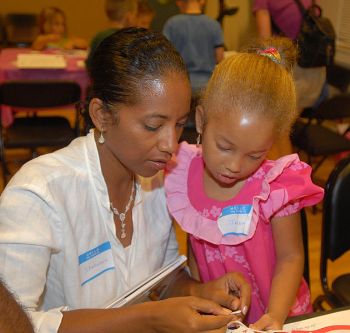
Tell me a story, a parent and her child, with focused attention (Wikipedia)
Recently a fellow, Matt Killingsworth, developed an app for measuring how happy people are when doing various things. He got responses from 35,000 people. The conclusions: we are actually happiest when immersed in what we are doing. So, maybe it is as simple as that, over and over again, just "be here now." Like the baby really curious about his or her environment, like a person in love, like many one-on-one personal interactions, like someone grasping a fresh insight, like an artist truly seeing what is to be drawn, like a person focused on another's communication, listening to the words, watching each facial expression, like someone learning to do a thing for the first time, perhaps we are at our best when fully engaged.
 Tell me a story, a parent and her child, with focused attention (Wikipedia) |
According to Killingsworth, one counterintuitive finding was that it need not matter whether one particularly liked the task. One could be well engaged in cleaning a small part of the house, washing the car, commuting to or from work, or doing a specific part of an "unrewarding" job. So long as it was done with good attention, there was a similarly positive effect as when actively involved a pleasant hobby, and, indeed, the well attended to undesirable task could be more pleasurable than a favorite activity when the latter was done without good focus.
Why does it work? Humankind enjoys a great advantage over its competitors in the animal kingdom, our relatively super brains. Hypothetically at least, evolution has given us feelings of greater satisfaction when engaged in functional processing using this substantial mental resource. We enjoy doing what we can do well. On the other hand, when we are not efficiently focused, our gray matter still needs stimulus and finds it in the form of daydreaming and obsessing. All too naturally, we tend to think with sadness, regret, or grievance about things we feel ought to have been different in our pasts, or we brood about what unfortunate things might happen in our futures. Such uses of these large minds are neither productive nor pleasing. Being fully engaged in the moment precludes such disturbing distractions and offers us instead the simple delight of doing what needs to be done or of really perceiving the objects of straightforward awareness.
Suppose this is true? What then? How do we lose ourselves in the moment? Apparently it is not rocket science. Focus on one thing at a time. If we notice ourselves beginning to daydream or otherwise to drift off from the current task, perception, or feeling, merely return to it, again and again. Notice, for example, the rise of the abdomen when breathing, the sound of the refrigerator, specific smells, traffic noises, tensions in one's muscles here and there, the shape and wrinkles in a person's hands, dust motes in a beam of light, insects to be photographed, birds in flight, the food on the plate, or...whatever.
Can full engagement in the moment be cultivated? Evidently so. Each person can find what methods work best for him- or herself. Here are a few suggested ways:
Certainly being fully engaged in the moment is not a perfect solution to all unpleasantness. We may still not like going to the dentist or being involved in a car crash. Yet if Killingworth's researches are correct, most of the time a simple shift of awareness, attending to the here and now, can be rewarding. So, the next time you find yourself wool gathering or brooding on a disturbing thought, you might try a simple alternative, for we can really only focus on one thing at a time, and switch the awareness to specific aspects of whatever you are already doing.